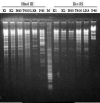Equine herpesvirus 2 (EHV-2) infection in thoroughbred horses in Argentina
- PMID: 16281971
- PMCID: PMC1308826
- DOI: 10.1186/1746-6148-1-9
Equine herpesvirus 2 (EHV-2) infection in thoroughbred horses in Argentina
Abstract
Background: Equine herpesvirus 2 is a gamma-herpesvirus that infects horses worldwide. Although EHV-2 has been implicated in immunosuppression in foals, upper respiratory tract disease, conjunctivitis, general malaise and poor performance, its precise role as a pathogen remains uncertain. The purpose of the present study was to analyse the incidence of EHV-2 in an Argentinean horse population and correlate it with age and clinical status of the animals.
Results: A serological study on 153 thoroughbred racing horses confirmed the presence of EHV-2 in the Argentinean equine population. A virus neutralization test showed a total of 79.7 % animals were sero-positive for EHV-2. An increase in antibodies titre with age as well as infection at earlier ages were observed.EHV-2 was isolated from 2 out of 22 nasal swabs from horses showing respiratory symptoms. The virus grew slowly and showed characteristic cytopathic effect after several blind passages on RK13 cells. The identity of the isolates was confirmed by nested PCR and restriction enzyme assay (REA).
Conclusion: This is the first report on the presence of EHV-2 in Argentina and adds new data to the virus distribution map. Though EHV-2 was isolated from foals showing respiratory symptoms, further studies are needed to unequivocally associate this virus with clinical symptoms.
Figures


Similar articles
-
Prevalence of equine herpesvirus-1 and equine herpesvirus-4 infections in equidae species in Turkey as determined by ELISA and multiplex nested PCR.Res Vet Sci. 2009 Apr;86(2):339-44. doi: 10.1016/j.rvsc.2008.06.001. Epub 2008 Jul 22. Res Vet Sci. 2009. PMID: 18649902
-
Equine herpesvirus infections in yearlings in South-East Queensland.Arch Virol. 2008;153(9):1643-9. doi: 10.1007/s00705-008-0158-y. Epub 2008 Aug 3. Arch Virol. 2008. PMID: 18677574
-
Prevalence of equine herpesvirus type 2 (EHV-2) DNA in ocular swabs and its cell tropism in equine conjunctiva.Vet Microbiol. 2006 Dec 20;118(3-4):260-6. doi: 10.1016/j.vetmic.2006.07.024. Epub 2006 Aug 11. Vet Microbiol. 2006. PMID: 16996233
-
EHV-1 and EHV-4 infection in vaccinated mares and their foals.Vet Immunol Immunopathol. 2006 May 15;111(1-2):41-6. doi: 10.1016/j.vetimm.2006.01.007. Epub 2006 Feb 28. Vet Immunol Immunopathol. 2006. PMID: 16513181
-
Detection of respiratory herpesviruses in foals and adult horses determined by nested multiplex PCR.Vet Microbiol. 2007 Mar 31;121(1-2):18-28. doi: 10.1016/j.vetmic.2006.11.009. Epub 2006 Nov 21. Vet Microbiol. 2007. PMID: 17208393
Cited by
-
Molecular Identification of Equine Herpesvirus 1, 2, and 5 in Equids with Signs of Respiratory Disease in Central Ethiopia.Vet Med (Auckl). 2021 Dec 18;12:337-345. doi: 10.2147/VMRR.S339042. eCollection 2021. Vet Med (Auckl). 2021. PMID: 34956854 Free PMC article.
-
Detection of Felis catus Gammaherpesvirus 1 in Domestic Cat Saliva: Prevalence, Risk Factors, and Attempted Virus Isolation.Pathogens. 2024 Jan 26;13(2):111. doi: 10.3390/pathogens13020111. Pathogens. 2024. PMID: 38392850 Free PMC article.
-
Effects of Mustelid gammaherpesvirus 1 (MusGHV-1) Reactivation in European Badger (Meles meles) Genital Tracts on Reproductive Fitness.Pathogens. 2020 Sep 20;9(9):769. doi: 10.3390/pathogens9090769. Pathogens. 2020. PMID: 32962280 Free PMC article.
-
Epidemiological and Phylogeographic Study of Equid Herpesviruses in Tunisia.Pathogens. 2022 Sep 5;11(9):1016. doi: 10.3390/pathogens11091016. Pathogens. 2022. PMID: 36145448 Free PMC article.
-
Whole genome sequence analysis of equid gammaherpesvirus -2 field isolates reveals high levels of genomic diversity and recombination.BMC Genomics. 2022 Aug 30;23(1):622. doi: 10.1186/s12864-022-08789-x. BMC Genomics. 2022. PMID: 36042397 Free PMC article.
References
-
- Kono Y, Kobayashi K. Cytopathogenic equine orphan (CEO) virus in horse kidney cell culture I. Isolation and properties. Natl Inst An Health Q Japan. 1964;4:10–20.
-
- Studdert MJ, Turner AJ, Peterson JE. Equine herpesvirus 1. Isolation and characterization of equine rhinopneumonitis virus and other equine herpesvirus from horses. Aust Vet J. 1970;46:83–89. - PubMed
-
- Horner GW, Hunter R, O'Flaherty JD, Dickinson LG. Isolation of equine herpesvirus from horses with respiratory disease. N Z Vet J. 1976;24:171–176. - PubMed
-
- Karpas A. Characterization of a new herpes-like virus isolated from foal kidney. Ann Inst Pasteur, Paris. 1966;110:688–696. - PubMed
LinkOut - more resources
Full Text Sources

